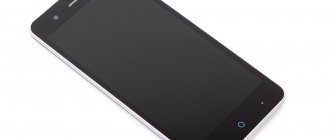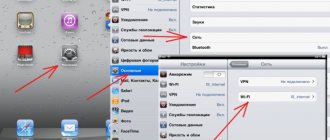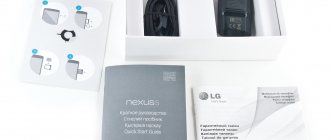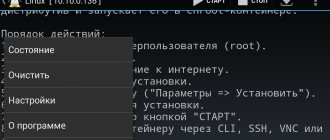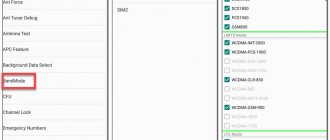Last week, the Russian Federal Antimonopoly Service took over Google. It launched an antitrust investigation into the complaint. The reason is that Google prohibits the pre-installation of competitors' applications and services on devices running its Android mobile operating system. The price of the issue is quite high. Last year, a billion Android devices were sold worldwide. In Russia, the share of Android smartphones exceeds 80%. The Village found out how the operating system came to be and why it became so popular.
Where did Android start?
The Android operating system was first announced as a product only in 2007. This happened two years after the takeover of Android by Google. Yes, Android is another startup that Google acquired and turned into a candy. It was in 2007, after the announcement, that Google released the first public version of Android along with an emulator, and also demonstrated the system on a BlackBerry-style push-button all-in-one. The device was created by HTC.
Around the same time, Apple introduced its first iPhone. Google, seeing a new revolution, turned Android development into a “touch direction”, abandoning the concept of BlackBerry-style devices.
The public version, called Milestone 3, was already focused on touchscreen use only. Later, test versions 0.5, 0.9 were released, and only then the first stable release took place.
Android 11 update on Google
As expected, Google Pixel phones were among the first to receive the latest version of Android. The company started rolling out the update on day one as usual, but unlike Android 10, not all Pixel phones will receive it - read below for details.
Google is rolling out Android 11 to all of its Pixel phones except the original Pixel and Pixel XL, which launched back in 2016. This was expected since Google only guarantees three major OS updates for each Pixel phone.
Android 11 release date for Google: September 8, 2020
Android 1.0 Apple Pie (2008)
By the time of the release of Apple Pie, quite a long time had passed since the acquisition of Android Inc by Google - about three years.
T-Mobile G1
The era of the Android operating system officially starts on October 22, 2008, when sales of the T-Mobile G1 smartphone running Android 1.0 began in the United States. This device is also known as HTC Dream. The device incorporated all the features of smart phones of that time: touch screen, horizontal QWERTY keyboard, GPS. If the iPhone at the same time had a minimum of physical buttons, then the HTC Dream was the complete opposite - almost all the controls known at that time were located on its body. In less than two years, 1 million smartphones were sold.
Even then, some of the fundamental features of Android were laid down: a notification system with a top “curtain”, widgets for the desktop, integration with Gmail, the Android Market application store. It is noteworthy that the Android interface was developed in collaboration with the Swedish company The Astonishing Tribe, which was later acquired by BlackBerry.
Then the operating system was codenamed Astroboy, but then the name was replaced by Apple Pie. The decision was made due to possible litigation. It was from that time that the tradition began to call Android versions various delicacies.
Android 11 update on Motorola
Motorola isn't known for its speed with updates. Looking at the Android 10 release schedule, we can expect the first update to be released towards the end of the year, December to be exact.
Motorola has a habit of releasing updates to a number of its phones in Brazil first and then rolling them out to other regions. With that in mind, you may have to wait even longer for the update if you're from the US or Europe.
Expected release date for Android 11 for Motorola: December 2020
Android 1.5 Cupcake (2009)
Only in April 2009, the Android 1.5 Cupcake update was released, which brought an integral part of modern operating systems - an on-screen keyboard. This way, manufacturers could release new phones without physical input keys. The first Android smartphone with full touch controls was the HTC Magic.
HTC Magic
Otherwise, the changes were extremely minor: new icons, a fresh design of the search widget, the ability to create multiple widgets for one program, a full implementation of the clipboard, video recording and playback, many improvements in standard Google applications, setting wallpaper on the lock screen, improved zoom in the browser .
Android 4.0 "Ice Cream Sandwich"
Version Android 4.0 appeared in September 2011. Its intermediate versions were released until June 2014. During all this time, the operating system has received a huge number of changes. Appeared here:
- Improved spell checking;
- Traffic control;
- Data encryption;
- High-performance and functional camera;
- Autonomous voice input;
- Smooth interface animation “without jumps”;
- Google Now service;
- Well-thought-out notification panel;
- Supports multiple user profiles;
- Miracast technology;
- Supports connecting input devices via Bluetooth;
- Voice assistant “OK Google”;
- Large set of emoticons;
- Advanced synchronization with cloud services;
- Pedometer support;
- Android remote control.
There are so many changes and additions in Android 4.0 and in intermediate versions that they can be stretched over several pages. We have identified only the most important points. Thanks to them, Android devices have become full-fledged assistants of a modern person.
The advantages of Android 4.0 and later versions are enhanced work with external devices, rich functionality, improved user experience, high performance, reduced power consumption and much more. Disadvantages - slow operation on devices with a small amount of RAM, not very high stability.
Despite some shortcomings, devices running Android 4.x have become widespread - this operating system has received almost all the functionality necessary for smart smartphones and tablets.
Android 4.1, 4.2 and 4.3 Jelly Bean
Key changes:
- New features in the Camera app;
- Supports multiple user accounts;
- Widgets on the lock screen;
- 360 degree panoramas for publication on Google;
- Increased productivity;
- Voice input without Internet;
- Support for Braille input devices (for the blind);
- New gallery.
The number of changes is huge.
Android 4.4 Kitkat
Devices based on this operating system were produced for several years - it turned out to be popular and productive. A voice assistant, support for cloud storage, remote control, Chromecast, support for an infrared port, a sandbox, support for pedometers, an updated mail application, and support for cloud printers appeared here.
Android 1.6 Donut (2009)
Android has evolved quite quickly. In the same 2009, but already in September, the third update in a row was released under version 1.6. Donut was chosen as the name. One of the most important innovations was support for CDMA networks, which allowed Verizon and other operators to sell smartphones to their subscribers. Also an important change was support for screens with resolutions greater than 480x320 pixels. It was then that manufacturers gained freedom in terms of installing displays in their devices.
The Android Market application store has received a new design - now white and more pleasing to the eye. Also, screenshots finally appeared on the program pages - the user could look at what he was downloading.
An item appeared in the settings menu that talked about battery usage. Then it was in the “About phone” section. At least users could find out what exactly “eats” the battery charge so quickly. And the proprietary search widget has learned to search on the device and show results.
Android 11 update on LG
Going by the company's track record, the first LG phones are expected to receive Android 11 in December. These devices will most likely be the LG V60 and G8. The rest should appear relatively soon.
Keep in mind that the company usually releases software updates in its home country of South Korea first before rolling them out to other markets. This means that, depending on where you live, you may have to wait even longer (a month or so) to test Android 11 on your LG device.
Expected release date for Android 11 for LG: December 2020
Android 2.0 and 2.1 Eclair (2010)
The Android 2.0 Eclair update, introduced in November 2009, became truly epoch-making and significant in the history of the platform. It was the device with version 2.0 and subsequent updates that began to march around the world, capturing the mobile device market.
Motorola Droid
The first gadget with Android 2.0 was the iconic Motorola Droid, which was one of the favorite devices for geeks. The smartphone offered powerful hardware and stock Android with a lot of features. Motorola Droid came with a 3.7-inch screen (854x480 pixels), a single-core TI OMAP Cortex A8 processor and 256 MB of RAM. There was still room for a classic horizontal keyboard.
Important changes and innovations in Android 2.0 Eclair:
- Support for multiple Google accounts and the ability to integrate accounts from other applications (synchronization).
- Full turn-by-turn navigation in Google Maps with 3D display.
- New unlock screen with gesture.
- Updated design of the standard desktop with new icons and widgets. The appearance has become more modern and neat. Almost all elements have been redrawn for higher screen resolutions.
- On-screen buttons to control incoming calls with gestures. Now smartphones did not necessarily have to have hardware “Accept” and “Reject” buttons.
- A heavily updated browser with support for modern web standards at that time. Even HTML5 support was implemented with video playback. However, there were no multi-touch gestures for zooming yet. A full-fledged address bar has appeared.
- A more comfortable on-screen keyboard with a new design.
- Text-to-speech translation.
- Installing your own tracks for a call.
In January 2010, Google released a minor, but very important update for its subsequent strategy - Android 2.1 Eclair. The first smartphone from the Nexus line is being released based on this OS.
Nexus One
The device, called Nexus One, was created by HTC based on the then-new Qualcomm Snapdragon S1 processor with a frequency of 1 GHz. The device featured an AMOLED display. The main changes in Android 2.1 Eclair were external: animations, minor design changes, live wallpapers, etc. Later, Update 1 was released for the Nexus One, which brought support for a popular feature from the iPhone - multi-touch gesture for moving away and zooming in.
Android 11 update on ASUS
Asus was surprisingly quick to update its flagship Zenfone 6 smartphone to Android 10, releasing the update just two months after the OS debuted. So, unless the timing changes this year, the company should release the first stable Android 11 update sometime in November for the Zenfone 7 series.
Unfortunately, Asus has been slower to update its gaming ROG Phone 2. The update was released in March, six months after the launch of Android 10. We hope Asus speeds up the release of the ROG Phone 3 this year.
Expected release date for Android 11 for ASUS: November 2020
Android 2.2 Froyo (2010)
In mid-2010, the Android 2.2 Froyo (frozen yogurt) update was released, which immediately highlighted one of the main advantages of the Nexus line - the One smartphone was the first to be updated to this version. In update 2.2, Google developers focused on increasing performance and optimization. One of the important innovations was the JIT compiler, which could convert Java code into native code for fast execution.
The browser has become faster thanks to the integration of the V8 engine to increase Javascript performance. The desktop screen became more convenient, as the bottom panel became less useless - it now had two additional buttons - a dialer and a browser. The dots on the sides called up a menu with additional functions. Google adopted these functions from third-party shells - HTC Sense already existed then.
The gallery has undergone major changes. For the first time, 3D animations and objects appeared. We can say that this program was ahead of all others and Android itself in development. And it was in Android 2.2 that exclusive support for Adobe Flash appeared, which was downloaded from the Android Market and worked in a standard browser. You could watch videos and even play some Flash games. However, the module worked very slowly and unstable, so even watching the video was a problem. Around the same time, Steve Jobs would call Adobe Flash an outdated and slow technology. Many will disagree with this, but in the end they abandoned Flash in favor of HTML5.
By the way, it was in Froyo that it became possible to distribute Wi-Fi, that is, turn the device into a portable access point to share the Internet with other devices. For those who love passwords, we have introduced an unlock code.
Android 11 update on OnePlus
OnePlus has always been quick to release updates and the trend will continue with Android 11. The company released the Oxygen OS 11 open beta based on Android 11 for the OnePlus 8 and 8 Pro on day one. There's no word yet on when the stable version will be released, but based on previous years, we expect it to be available by the end of the month or early October.
Although not confirmed, we expect all OnePlus phones from OnePlus 6 to get the latest version of Android. After the OnePlus 8, the next phones that could receive the update are most likely the OnePlus Nord and the OnePlus 7T series.
Android 11 Open Beta is available to download for OnePlus 8 and 8 Pro – .
Expected release date for Android 11 for OnePlus: September/October 2020
Android 11 update on Xiaomi
Xiaomi is among the companies that released the Android 11 beta version on its release day. Unfortunately, the company did not announce the start date for the release of the stable version of the OS. Based on its track record, we expect the stable version of Xiaomi's MIUI with Android 11 build to arrive on Mi 10 phones by the end of September or early October.
Many other Xiaomi phones, as well as devices from its sub-brands Poco and Redmi, will arrive soon after this, although we don't know which models will receive the update.
Expected release date of Android 11 for Xiaomi: September/October 2020
Xiaomi has released the Android 11 beta version for Mi 10 and Mi 10 Pro phones. In a statement to Android Authority, the company said that the update is available to users who are part of their beta program on global and Chinese ROMs.
Android 11 update on Oppo
It looks like Oppo is speeding up the process this year, joining the list of companies that will release Android 11 beta on day one, according to Google. But Oppo has not yet confirmed which phones will receive the update, although it is likely to be the Find X2, Find X2 Pro, Reno 3 and Reno 3 Pro. We will update this post as soon as this is confirmed.
However, the company generally takes its time with updates, and if the situation is similar this year, we can expect the first stable version of Color OS with Android 11 to be released around six months after the release of Android 11.
There's a chance that Oppo will roll out updates faster this year given that a couple of its phones are part of the beta program, but since the company hasn't yet shared a release schedule, it's impossible to make any firm promises.
Expected release date for Android 11 for Oppo: March 2021
Android 11 update on Realme
Realme knows that fast updates are important, so it released a closed beta of Android 11 on day one - see below for more details. He didn't say when the stable version will be ready, so we have to base our prediction on how the company handles Android 10 updates.
The first one was released back in January, four months after the official unveiling of Android 10. It's possible that the company will speed up the process since it has already released a beta version of the update, but since we don't know for sure, we assume that Realme will stick to the same time frame , as with Android 10.
Expected release date of Android 11 for Realme: January 2021
Android 11 update on Sony
Sony's latest Xperia 1 II is likely to be the company's first phone to receive the Android 11 update, followed by the slightly older Xperia 1 and Xperia 5. The update should also make its way to a few older flagships, as well as a number of mid-range ones. - Rangers.
Sony hasn't yet shared its Android 11 plans with the public, but we expect the tech giant to release its first stable update sometime in December, just like Android 10. But if you have a mid-range Sony phone that's likely everything will get the latest version of Android, you will have to wait. Last year's Xperia 10 and 10 Plus received Android 10 back in May.
Expected release date for Android 11 for Sony: December 2020



